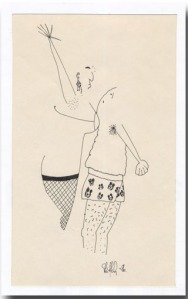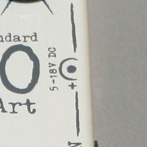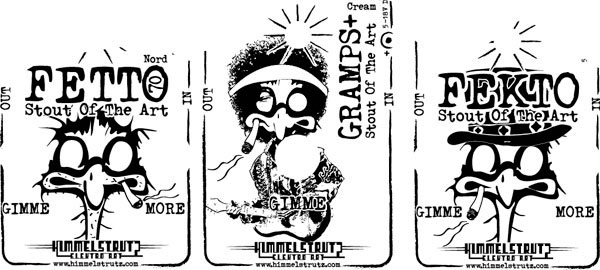Here is a great interview by Make'nMusic with Joakim from Himmelstrutz Elektro Art pedals...
In this month’s blog post, we sit down with Joakim Hedeby, the founder and creator ofHimmelstrutz Elektro Art and talk about his incredible “Fetto” line of pedals, what makes him tick and what’s going on next with this monster of a company. 
The circuits you’ve come up with in your pedals are unbelievable. Pedals like the FETTO Standard and the FETTO/FAT-oh Nord accentuate your amp’s tone and truly sound like your amp just got “that much better” rather than most distortion or overdrive pedals on the market that just sound like “oh, I just turned on a pedal.” You’ve obviously been working on electronics for a while, but how’d you get your start?
Fetto Standard
The love for sound was born long ago, around 1976-1988, I guess ever since I heard Thin Lizzy for the first time, that magical Saturday 1976 on the Swedish radio with the song “Jailbreak” I was lost. Since then lots of things have happened in the world, but in the guitar pedal world it seemed like the time stood still, they didn’t do the guitars/amps justice, and still often don’t. I needed tools to make it sound better, not the opposite, and then the Himmelstrutz pedals

FAT-oh Nord
(FETTO) were born. The FETTO’s, or actually most of the Himmelstrutz pedals of today, are made to make what you
describe possible: to make your beloved amp still sound like the amp you once acquired, probably for a good reason, which also includes the guitar(s) connected. If you at least want those “simple” parts to work the Himmelstrutz pedals for sure can help you.
You really seem to make some truly multi-functional pedals like the Under Over booster. Do you feel that there’s a specific order in which your pedals sound the best? What’s your take on pedal order?

Under Over booster
I would say it works the way you want it to work. Personally I like to switch the order of most of them, depending on what to be solved that specific day. Some times I need to boost a drive pedal – why not with some extra pre eq, “under OVER” (UO), and other days I prefer to route the boost/eq – and/or the opto dynamic booster, “miss nutCRACKer” (MNC), after the dirt section which would be a “FETTO“, “GRAMPS+“

Gramps+ Fuzztortion Grande
or the coming “TONKER” (so far a working name). When using effects, like delays or reverbs, I want to make sure I still have a proper bypass system, to not destroy the “original” tone, as well as the ability to adjust both the amount of effect and the overall level(s) To make this possible I apply the effects in parallel mode, through “FEKTO” connected last in the chain.
I love that the name of the company and your pedals are honoring Swedish author StureDahlström. Where’d that idea come about?

Swedish author Sture Dahlström
Sture was an amazing writer that not many know about. It’s a shame his work isn’t translated to all existing languages and a few more, because I’m sure his style and novels would be appreciated by all people having interests in more than 3 Dimensions. My company name (Himmelstrutz) and a few of the pedal names are to honor him and the characters in his books. He has inspired me a lot – his writing style and his novels were/are matchless!
So unfortunately he died in 2001. What happens when you run out of characters to name your pedals on?
As Sture had a unique ability to use words for making surreal ‘paintings’, his characters and stories were a bit like his wives, Anna Stina Ehrenfeldt’s art. I don’t think the naming of the pedals will be a problem, even if he’s not around anymore. I always try to pick an appropriate name that describe well the character of the specific pedal. If it’s still not 100% clear what to expect when buying one, most are accurately described at www.himmelstrutz.com. So visually, your pedals are pretty cut and dry. No super fancy over-the-top hand painted pedals, just clean, white and simple. But then that leads me to the next question…. where’d the bird come from? He looks like he’s been on a bender for about a week on the FETTO Standard and the FETTO Custom and then looks pretty angry on the FAT-oh Nord. Then he takes a trip to the costume shop for his Woodstock outfit on the GRAMPS+ fuzz.

The original artwork from 1986
The layout and colors is what just happens. The very early FETTO Standard (version 9.0) didn’t have the bird, it showed how strong and beautiful the woman is compared to the tiny little man with his Mickey Mouse underwear. This artwork was made by my brother Peter in 1986 and looked like this: (See left)

Joakim s father s drawing of the ostrich
The bird layout was quite a coincidence. As the ending of the word “HimmelSTRUTZ” reminds of “STRUTS” (=ostrich in Swedish) the artwork just had to be like that. My dad arranged the original artwork, which looked like this: (See right)
Now and then this bird changes, and sometimes also the names of the pedals, which more or less reflects the mood of the day or season. Even if It’s a great joy making all the way original pedals it’s possible to get a little bored with some details. Therefore these changes can occur, at any time. It’s also a good way for developing new pedals. Some variants of the bird are:
Each of the Himmelstrutz Elektro Art pedals come loaded with a 9v battery installed in the pedal but each pedal is listed as being able to take an AC adaptor from anywhere from 5-18 volts. What advantages does a user of your pedals get by using different voltages?
 The pedals sound truly different at different voltages. For aFETTO with 12 volts instead of the default 9 volts – the sound is more articulated, steady and rougher – much like comparing a 20 watt amp with a 50 or 100 watter. Definitely worth a try! At 15 volts even more will happen, which may be “too rough” for some users, and even if 18 volts is allowed it’s not recommended sound-wise. If we go down to the minimum, 5 volts you will get a lot more compression/distortion in the FETTO‘s and the GRAMPS‘es may as well be over-saturated and crazy, for good or for bad. The 5 volt option is more if you would like to get extreme, you get more “funny” effects, like if you play in a puppetry show.
The pedals sound truly different at different voltages. For aFETTO with 12 volts instead of the default 9 volts – the sound is more articulated, steady and rougher – much like comparing a 20 watt amp with a 50 or 100 watter. Definitely worth a try! At 15 volts even more will happen, which may be “too rough” for some users, and even if 18 volts is allowed it’s not recommended sound-wise. If we go down to the minimum, 5 volts you will get a lot more compression/distortion in the FETTO‘s and the GRAMPS‘es may as well be over-saturated and crazy, for good or for bad. The 5 volt option is more if you would like to get extreme, you get more “funny” effects, like if you play in a puppetry show.So what’s on Joakim’s pedalboard at home? I’m sure there’s a handful of Himmelstrutz pedals on there, but do you have little crazy boxes you’ve made that haven’t quite made it into production?
Lots of prototypes etc are available here, and my personal “board”, is not a steady thing as I often want to change the order and sounds. It’s not a “pedal board”. It’s a sweet chaos of pedals standing or laying on the floor, mostly Himmelstrutzers, always some kind of FETTO and most likely a GRAMPS+. These pedals can then be tone shaped by Miss Nutcracker, Under Over or a “FITZO“. The pedals are connected with different kinds of multi colored cords, often low quality, to be able to test what might happen when the pedals are connected to “whatever”. This is interesting and important, which of course would not be appropriate for a working musician but it’s necessary to be able to test also the “worst cases”. Now and then, as mentioned above, delay/reverb effects are used, for example the Line 6 Echo Park (routed in parallel as its bypass system for me isn’t perfect) – this effect can be very useful this way! Since a few days back I also have a TC Flashback which I still haven’t had the time to evaluate. Some times I connect rack multi effects from the 80′s – oh yes, through “FEKTO” again – and at times it’s possible I may use an Arion SCH1 Chorus, more for “fun” than trying to get “good” sounds.
Where do you see Himmelstrutz pedals in 5 years? Do you notice trends happening in the pedal industry you might follow?
What’s a trend worth? Himmelstrutz Elektro Art is here to offer, and deliver, the best quality both in hardware and tone, and so far it’s all handmade by one person in Sweden. If that’s what’s needed to keep the quality, and if people want it, this will remain. Hopefully also in 2016.
Joakim Hedeby, Himmelstrutz Elektro Art, Sweden












